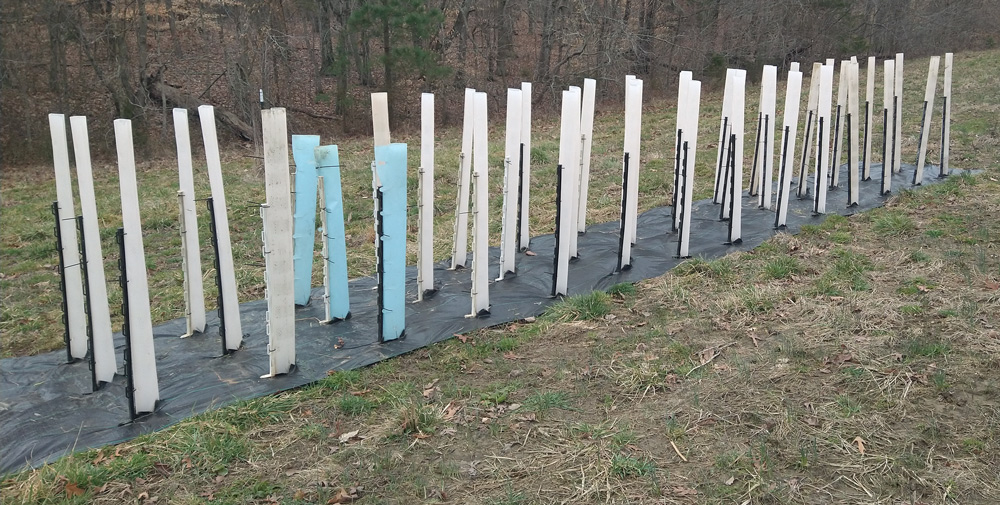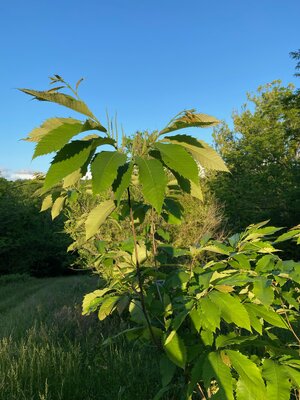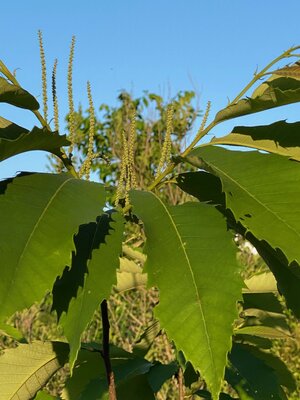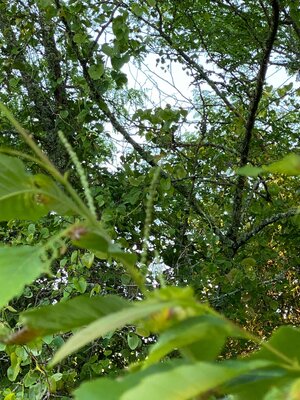-
The forum has been upgraded to support both light and dark themes. Click here for directions.
You are using an out of date browser. It may not display this or other websites correctly.
You should upgrade or use an alternative browser.
You should upgrade or use an alternative browser.
Ozark Chinquapin
- Thread starter letemgrow
- Start date
yoderjac
Well-Known Member
I took my ACs out of the fridge a couple weeks ago and put them in a bucket of peat in the barn. Last week, I put down some weed barrier. As soon as the rain stops, My plan is to direct seed nuts with root radicles. I plan to plant them close and cull down the road. Mine often take a bushy form anyway. I plan to slit the weed barrier, plant the nut, and put a tube over it. Hopefully since they have germinated, the failure rate will be low.I direct seeded all that I got from yoderjac and saved my growing efforts for chestnuts. I’m going the fact they don’t have to be cold stratified will help them take off soon. I put them in tubes last fall.
TX-Aggie
Active Member
My family has been getting and planting nuts for the past 5-6 years (I think there is a off year in there where we didn't receive nuts). Our first nuts planted were rough and only 1 or 2 survived, but barely due to us not knowing much. We have 2-3 trees that should start producing this year hopefully, we are going to keep a watch on them.
Our new process which has worked well the last 2 years (this will be our 3rd year on this process) : Nuts delivered to the Texas residents of the family. After the final threat of hard frosts (I shoot for a week of 50+ deg nights), we start them in organic natural starter soil (we like Fox Farms Coco Loco) mixed with some mycorrhizae spores (we like Big Foot brand), and planted in tree start tubes about 12" long. We pull the nuts out of the fridge a week prior to starting them. Once started, water enough to keep the soil damp but not soaked. Let them grow and grow until planting in mid-April (typical time period for last frosts at our farm in Missouri). Our best growing areas have been just over the break of a southern facing hill/side slope that is gradually falling steeper. Also, has some grown trees blocking the western afternoon sun - that way they get morning to midday sun, and not get cooked in the hot afternoon sun. My father is going to take 3 this year, and try to get them growing in a common area of his neighborhood close to his backyard - he wants to "baby" them and see what they can really do.
My next trip to the farm will be in April for turkey season, spring food plotting, and planting chinquapins. I'll update the thread with what we have going.
Our new process which has worked well the last 2 years (this will be our 3rd year on this process) : Nuts delivered to the Texas residents of the family. After the final threat of hard frosts (I shoot for a week of 50+ deg nights), we start them in organic natural starter soil (we like Fox Farms Coco Loco) mixed with some mycorrhizae spores (we like Big Foot brand), and planted in tree start tubes about 12" long. We pull the nuts out of the fridge a week prior to starting them. Once started, water enough to keep the soil damp but not soaked. Let them grow and grow until planting in mid-April (typical time period for last frosts at our farm in Missouri). Our best growing areas have been just over the break of a southern facing hill/side slope that is gradually falling steeper. Also, has some grown trees blocking the western afternoon sun - that way they get morning to midday sun, and not get cooked in the hot afternoon sun. My father is going to take 3 this year, and try to get them growing in a common area of his neighborhood close to his backyard - he wants to "baby" them and see what they can really do.
My next trip to the farm will be in April for turkey season, spring food plotting, and planting chinquapins. I'll update the thread with what we have going.
letemgrow
Well-Known Member
That's an oft overlooked issue IMO.Also, has some grown trees blocking the western afternoon sun - that way they get morning to midday sun, and not get cooked in the hot afternoon sun.
Young seedlings can handle a lot more drought stress if the hot afternoon sun isn't as much of a factor.
hoocli
New Member
What tubes do you have the most success with?I planted more today. I'm now up from 9 to 32. I rand out of tubes, so I need to get some more before I can plant the rest.
I'm looking at getting these. Any recommendations?
https://tree.tube/collections/store/products/miracle-tube-tree-shelters?variant=29054876450934
Brianb3006
New Member
Another supplier of tubes.

 www.treepro.com
www.treepro.com
Sent from my iPhone using Tapatalk Pro

Miracle Tube | Tree Grow Tubes - Seedling Tubes - Plant Tubes
Miracle Tube Grow Tubes for Trees are the #1 Tree Tubes for seedling trees. Tree Tubes provide a protective environment from inclement weather conditions, rodents, deer rub, and browse. Our Grow tubes are vented to create a micro climate within the tube to promote plant growth and better...
Sent from my iPhone using Tapatalk Pro
yoderjac
Well-Known Member
I have not tubed ACs before. Since they grow native on my farm they don't seem to get extra attention from deer. Since the nuts are free to me and I was starting my trees indoors under lights in a root pruning container system. By the time I planted them, they needed no protection from deer.What tubes do you have the most success with?
I'm looking at getting these. Any recommendations?
https://tree.tube/collections/store/products/miracle-tube-tree-shelters?variant=29054876450934
I had to buy chestnuts to grow from seed and deer seemed to pay more attention to them. So, I did use tree tubes on chestnuts. I used two kinds, Plantra and Blue Tubes. The Blue tubes were much cheaper but took more time to assemble. Both types worked well for me with chestnuts.
TX-Aggie
Active Member
What tubes do you have the most success with?
I'm looking at getting these. Any recommendations?
https://tree.tube/collections/store/products/miracle-tube-tree-shelters?variant=29054876450934
Those are the ones that work best for us. Oddly, we accidently installed some upside down with the holes at the bottom, and performed much better than the holes at the top. We now use those almost exclusively for the Chinquapins and install "upside down". Once they start poking out of the top of the tubes, we cage as well.
We tried the green ones and green ones with slits that didn't work well with the Chinquapins, but worked with oaks. We are going to start taking the green ones, and cut them down for rodent girdling when we pull tubes off our 4-5 year old trees in April.
I'm still trying to figure out the best stakes. Fiberglass were great but expensive and tough to find. Regular wood stacks rot too quickly. Plastic deteriorate in the sun too quick. Bamboo has been tough to get quality pieces - half are good / half are bad when ordered. I'm worried about t-posts cutting roots when removing.
yoderjac
Well-Known Member
Those are the ones that work best for us. Oddly, we accidently installed some upside down with the holes at the bottom, and performed much better than the holes at the top. We now use those almost exclusively for the Chinquapins and install "upside down". Once they start poking out of the top of the tubes, we cage as well.
We tried the green ones and green ones with slits that didn't work well with the Chinquapins, but worked with oaks. We are going to start taking the green ones, and cut them down for rodent girdling when we pull tubes off our 4-5 year old trees in April.
I'm still trying to figure out the best stakes. Fiberglass were great but expensive and tough to find. Regular wood stacks rot too quickly. Plastic deteriorate in the sun too quick. Bamboo has been tough to get quality pieces - half are good / half are bad when ordered. I'm worried about t-posts cutting roots when removing.
For most of my chestnuts and other trees, over the years, I've used PVC. I don't like solid stakes, I want mine to bend in the wind so trees don't get brittle. The longer you leave them tubed or staked the more this matters. For my high value trees, I used cages made of cement wire. I like that because it stands on it's own. you can just stake the bottom foot with rebar to keep them from moving. I would then string rope across the cage with 2 strands in each direction near the top. It captures the seedling. This lets the seedling blow significantly in the wind but it is limited by the rope so it does not get too much. I like this method best for valuable trees.
For the trees I tube, I don't like holes near the bottom. This may depend on your location and climate. I found that holes near the bottom can create a chimney effect as the tube heats up and the hot air rises. This can cause small seedlings to dry out. On the other hand, if you have no air flow, you can create humid conditions where mold thrives in the tube.
It is all about figuring out what works best in your specific situation. I would not use tube at all if I was in an area where I did not need to worry about deer browsing. One year I had more chestnuts than I had tubes and planted some with not protection. Years later, those that survived are bushes with no central leader. I doubt they will ever produce nuts, or at least not for many years.
I don't have that concern with ACs. They will bear nuts in just a few years regardless if they take tree or bush form.
For the ACs that I just planted at my retirement property, I just used what was easy. I had a bunch of step-in electric fence posts sitting around from a Gallagher-style e-fence I used years ago. Since I was direct seeding nuts in tubes and there was no digging involved, they were very convenient. At my farm, I often planted ACs with no protection. Although we had high deer densities. we had lots of native ACs, so deer were used to them. They got browsed a bit but generally not killed. Since AC produce nuts in bush form, it was just easier and cheaper to plant them with no protection. At my retirement property, I've got security video cameras on the barn near where I planted these ACs. We had a mast crop failure this year, and I'm seeing up to 15 deer at once around the barn at night eating the WR/Clover/PTT I planted. I know they would paw up these nuts if I did nothing here. I'm hoping after a year or two to remove the tubes.
1/2" PVC pipe. Buy in 10' lengths and cut in halfI'm still trying to figure out the best stakes. Fiberglass were great but expensive and tough to find. Regular wood stacks rot too quickly. Plastic deteriorate in the sun too quick. Bamboo has been tough to get quality pieces - half are good / half are bad when ordered. I'm worried about t-posts cutting roots when removing.
TX-Aggie
Active Member
6 of the 9 that sprouted are doing well in the tree starter tubes. 3 of the 9 dropped their leaves 2 weeks ago suddenly, but have started a new leader this week, so I hope/think they are alright. Not sure what got them - may have been too much water as we've had some good rains in Houston this spring. My father's nuts are about 2.5-3 weeks behind, but I noticed he had them in a more shaded area than I was doing. We have moved them all into a good area for sunlight and ease of watering. They are now under his care for 2.5 more weeks when we go to the farm for turkey hunting and spring foodplot planting.
TX-Aggie
Active Member
Planted 15 more Ozark Chinquapins last week at our farm. Perfect timing ahead of the rain front blowing in, so they got a good soil drench.
Didn’t get many pictures - working to hard for turkeys while getting skunked, and working around the farm.
Our oldest most promising Ozark Chinquapin has an issue coming out of winter - it is 5 years old now, and started leafing out later than all the other ones around it. We removed the tubes to see the trunk for damage or the blight - saw nothing, but appears a sucker has started growing out of the roots. Both look alive still, so we left it and will monitor going forward.
Below picture is a 1 year old tree, my father planted it and is super proud of its progress in year 1 (especially since his brother’s is half the size 25 yards away - you may grow old but never grow up apparently when it comes to sibling rivalries). Anyways, the one picture I did take :
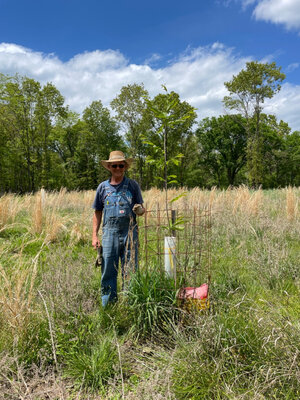
Sent from my iPhone using Deer Hunter Forum
Didn’t get many pictures - working to hard for turkeys while getting skunked, and working around the farm.
Our oldest most promising Ozark Chinquapin has an issue coming out of winter - it is 5 years old now, and started leafing out later than all the other ones around it. We removed the tubes to see the trunk for damage or the blight - saw nothing, but appears a sucker has started growing out of the roots. Both look alive still, so we left it and will monitor going forward.
Below picture is a 1 year old tree, my father planted it and is super proud of its progress in year 1 (especially since his brother’s is half the size 25 yards away - you may grow old but never grow up apparently when it comes to sibling rivalries). Anyways, the one picture I did take :

Sent from my iPhone using Deer Hunter Forum
TX-Aggie
Active Member
My father is back at the property this week to meet with Missouri Department of Conservation on burn plans.
3 of our Chinquapins in the original grove planted have catkins this year
3 of our Chinquapins in the original grove planted have catkins this year
Attachments
Similar threads
- Replies
- 12
- Views
- 883

